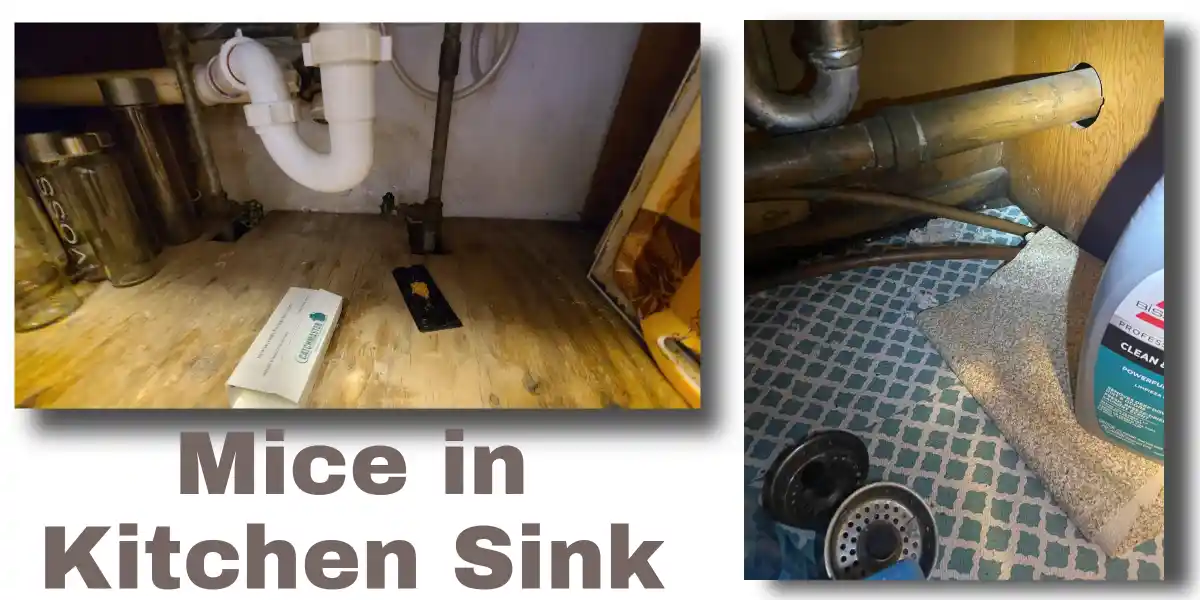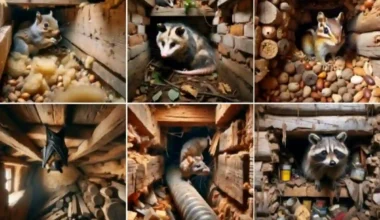Roof rats pose various problems for homeowners such as damaging furniture and walls and ceilings, and carrying diseases that could endanger one’s health. If you have recently heard squeaking noises or noticed droppings near your walls and ceilings, it could be a roof rat infestation. In this post, you will learn how to get rid of rats in walls and ceiling and stop them from coming back.
How to get rid of rats in walls and ceiling

Eliminating roof rats in walls and ceilings can be rough due to the difficulty of accessing these areas of the house. Fortunately, there are several methods available to effectively get rid of rats in walls and ceiling:
1. Sanitize your wall and ceiling areas
Sanitizing the affected walls and ceiling is one of the most effective ways to eliminate roof rats in walls. This involves thoroughly cleaning the entire property and removing anything that can sustain their survival.
You want to employ proper cleaning techniques to safely remove rats. Here are some tips for proper sanitation:
a. Declutter and remove their nesting materials
Rats are attracted to cluttered areas since they provide warmth for nesting and burrowing. Regularly check the area, including your walls and ceiling for any accumulated clutter and discard any unnecessary items, including stacks of paper and cardboard boxes stored in the attic or basement. Only store items in heavy-duty plastic boxes to prevent rats from chewing through them. Additionally, rats tend to chew on electrical wires, which can cause fires when exposed, so keep electrical wires organized.
b. Dispose of your garbage
Rats search through your garbage for food, and unlike mice, they eat almost anything, including trash. Ensure that your garbage bin is adequately covered, and replace it if it has any holes or cracks.
c. Ensure adequate garden maintenance
Rats can find shelter in your home through your garden, as they can feed on any fruits or vegetables growing there. Harvest any produce immediately and regularly trim tree limbs or long grass to reduce accessibility to indoor spaces. Bird feeders can also attract rats to the garden, so sweep or pick up any fallen bird seeds.
d. Remove rat urine stains
In the case of a severe infestation, rats usually leave urine pillars, which they use to navigate around your house. These urine pillars can accumulate over time and are difficult to clean. Use the proper cleaning products to remove the urine.
2. Invest in rodent repellents
Using rodent repellents is another cost-effective and efficient way to eliminate roof rats. These repellents are widely available in the market, and you can also create some homemade ones using household items.
Place the following repellents near walls, attics, basements, and around your home to keep the rodents away.
a. Pungent odor solutions
Rats have a strong sense of smell, so they tend to avoid food with pungent odors such as onions, Tabasco sauce, garlic, and pepper. These kitchen items can serve as rodent repellents.
b. Home-made scents
Household items with strong scents can also get rid of rats in walls and ceiling due to their keen sense of smell. Peppermint oil, citronella oil, and ammonia are some examples of items you can use.
Soak a cotton ball in these items and place them near walls and areas with high rodent activity. You can also dilute these items in water and transfer the solution into a spray bottle to create a homemade rodent-repellent spray.
c. Commercial repellents
Commercial repellents are readily available in stores or online. These products are usually made with chemicals and poison to get rid of rats in walls and ceiling.
Another option is electronic rodent repellents, which emit ultrasonic sounds that rats find annoying even while hiding in your walls or ceiling. These devices can be plugged in and used as an alternative to chemical repellents.
3. Place rat traps
Trapping is another popular and affordable way to get rid of rats in walls and ceiling. Traps come in various types, such as snap traps, and electronic traps. However, before using traps, there are a few things you should know to make them more effective:
1. Use the right bait
Although rats feed on almost anything, some types of food are more enticing than others. Peanut butter, fruit, grains, and seeds are examples of bait that can make your trap more effective. If food doesn’t work, you can use nesting materials like cotton, yarn, shredded paper, or dental floss.
2. Don’t touch bait with bare hands
Handling your bait without gloves will contaminate its scent. Rats consider you a predator and tend to avoid food with human scent. Also, if you touch, for example, a bucket rat trap with bare hands, it may not be effective, so use gloves when handling your setup.
c. Place the trap properly
Rats are intelligent creatures and tend to avoid foreign objects placed in their path. To outsmart the rodents, place unset traps for a few days to make them familiar with the device and believe it’s safe. If you’re trying to eliminate rats in walls, for instance, place the trap perpendicular to the walls to prevent them from evading the traps. Try out different traps and baits to find out what works best for you.
Don’t use sticky traps; those are considered inhumane. Also, rats can escape sticky traps and won’t return.
4. Seal all entries
Prevent more rats from entering your home by sealing them with tough materials that they can’t chew through. Rats do typically enter homes through small gaps and holes, even the size of a quarter or larger. Caulk up those tiny holes with the
a. Steel wool
When used together, caulk and steel wool create a compound that can seal and smooth almost any surface. This combination effectively prevents rats from chewing or gnawing through holes.
b. Sturdy materials
Materials such as glass, metal, strong concrete, and hard plastic can also block out rodents. These materials are available at hardware stores or can be made from scraps lying around your home.
c. Wire mesh
Wire mesh or sheet metal is suitable for sealing larger areas such as doors and windows. This allows air to circulate indoors while keeping rats away from your home.
5. Look out for signs of rats
After getting rid of rats in walls and ceiling using the aforementioned methods, you want to check for any remaining signs of rodents in your home to be sure all rats are gone from your ceiling and walls.
You can find out if there are any more rats using the flour test. Sprinkle some flour or powder near the walls, ceiling area, and around your home, then check for any marks or rat footprints after a few days. If there are any marks or footprints, it’s a sign that rats are still present on the property.
Another way to determine if there are still roof rats on your property is to observe your pet’s behavior. They will react differently when they see rats. Your pets may make sounds to draw your attention or appear to be in a chase.
What do roof rats look like?
Differentiating a roof rat from a Norway rat or house mouse can be challenging due to their similarities. However, understanding their specific differences can be advantageous in creating effective strategies to eliminate pests. To identify a roof rat, observe the following characteristics:
1. Looks
In comparison to Norway rats, roof rats have black fur, a pointed nose, and a scaly tail. They differ significantly in size, with an adult roof rat’s body measuring around 6-8 inches long and up to 18 inches long with their tails. Additionally, their tails are scaly and noticeably longer than their bodies.
2. Behavior and noise
Roof rats tend to inhabit higher areas, which is why you often hear noises in the attic, ceiling, or walls during an infestation.
They seek shelter in ceilings, sheetrock, cabinets, and inside walls. Outdoors, they find refuge under wood piles and dense vegetation.
In contrast to Norway rats, roof rats climb utility lines and tree limbs to move around and gain entry indoors. They can also infest houses by swimming in pipes and gnawing through various materials.
3. Poop and urine
Fresh roof rat droppings are soft and moist, but they dry out over time. They measure around one and a half inches and have pointed ends. Their urine appears as thin spots or streaks with tail marks dragging through them.
Signs of roof rats in walls and ceiling
If you suspect roof rats in your walls and ceiling, look out for the following signs:
1. Tracks near your walls
Look for grease marks along baseboards, drawers, or shelves. These marks are typically made of dirt or dust and may include tail marks.
2. Gnaw marks and scratch sounds
Inspect for chewed holes in food packaging or gnawed edges on wood and pipes. Roof rats will also chew on wood structures, electrical wiring, and insulation in your walls and ceiling.
3. Poop
Look for small, dark droppings that are slightly larger than a grain of rice, measuring up to half an inch. You may find them in cupboards, near food sources, or wherever else the rats have been active. If you can peek into your walls or attic, you should be able to see them easily.
4. Burrows
Check for small tunnel openings in and around your insulation. They tunnel through attic insulation, so keep an eye out for anything that looks unusual.
Common ways to keep roof rats from returning
Rats can be tough to eliminate once they’ve taken up residence in your ceiling, attic, or walls. Here are some tips to keep them out for good:
1. Store food and water properly
Rodents are attracted to various types of food, such as nuts, fruits, grains, seeds, sweet and salty snacks, meat, and pet food. When food and water are easily accessible, rats are more likely to stay and breed in your home.
To prevent them from having access to these sources, store food and water properly. Rats have sharp teeth that can gnaw through food packaging, thus, keep your food in airtight containers, glass jars, or metal containers.
You should also make it a habit to empty out any bowls or glasses of water to prevent the pests from using them as water sources.
2. Caulk up holes leading inside the house
Roof rats are skilled climbers and can fit through small openings. Ensure that your windows and doors are correctly sealed and repair any holes in your screens or vents.
3. Eliminate their shelter
Trim back trees and bushes that provide roof rats with a place to hide. Keep your yard clean and free of debris.
Contact your local pest control
It can be to tough deal with rats in your walls or ceiling, especially because they are hard-to-reach parts of your home. If you suspect an infestation, make sure to quickly contact professionals to exterminate rats from your home and keep them from returning.






